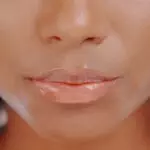
January 13, 2022 — 10:26 AM
In my youth, I was no stranger to lip plumpers. I remember those little glosses like it was yesterday. Well, let me rephrase: I remember the stinging, tingly sensation like it was yesterday. With one sticky swipe your lips would start to feel warm and practically start to vibrate. The formulas often contained slightly irritating ingredients—like certain essential oils, menthol, or even hot pepper—which trigger a localized inflammatory response. This would cause swelling, and a temporary plumping effect. As they say: Beauty is pain or, at the very least, temporary discomfort.
These days I stick to only hydrating numbers. As I’ve gotten older, I’m all about skin strength and integrity—and far less about the aesthetics of it all. Caring for your skin’s health and longevity will set you up for success now and far down the line. And offering your lips ample hydration will have the pleasant side effect of adding a subtle, supple look. (OK, I’m less concerned about the aesthetics of it all but not entirely devoid of vanity. You caught me!) And one of my favorite ingredients to get naturally plush lips is a very famous humectant: hyaluronic acid. Yes, the star ingredient in many-a-hydrating serums makes a fabulous addition to lip balms.
The one ingredient to look for in lip balms for a supple pout.
Hyaluronic acid is a naturally occurring humectant, which is a class of ingredients that binds and holds water. HA in particular has amassed a following because it can hold up to 1,000 times its weight—making it quite the workhorse. “Hyaluronic acid is produced by the body and found in the highest concentrations in our skin,” says board-certified dermatologist Jennifer Chwalek, M.D. “It functions to retain water and keep our skin looking firm and youthful.” But, like many good things, natural supply diminishes as we age. And because of this reduction, you may see a loss of plumpness and increased dryness. The lips are a very delicate area of the skin, as they’re much thinner than the rest. This means that when changes happen in the skin—i.e., loss of elasticity, volume, and density—they will be more noticeable in the lips.
lip balm
Instantly hydrates and protects chapped and flaky skin

So when you apply hyaluronic acid topically, “it draws water into the stratum corneum, the top layer of the skin. It gives an immediate improvement in the way the skin looks—less ashy, dry, dull,” says holistic dermatologist Cybele Fishman, M.D. And since it’s attracting so much water to the area, you’ll also see a fuller and more lush appearance. It makes sense why it’s often formulated into lip products, no?
Now, if you want to get into specifics, there are actually different molecular weights of hyaluronic acid. (This is important because things with lower molecular weights can shimmy down deeper than those that are larger.) Cosmetic chemists often use different varieties and weights depending on the intended purpose. For our lip balm we used sodium hyaluronate. This is the sodium salt of hyaluronic acid, which has a lower molecular weight and therefore can reach deep down into the skin barrier, providing a more lasting and meaningful hydration.
And as is the case with any humectant, it should be formulated right alongside emollients and occlusives. Otherwise, humectants can have the unintended consequence of making your lips drier, as they can trigger transepidermal water loss once they start to lose binding of the water they once attracted. Read: Don’t just apply your HA serum to the area and call it a day. You either need to top it with a balm—or just find one with the ingredient already infused into it.
https://www.mindbodygreen.com/articles/how-hyaluronic-acid-can-improve-your-skin-and-lips








